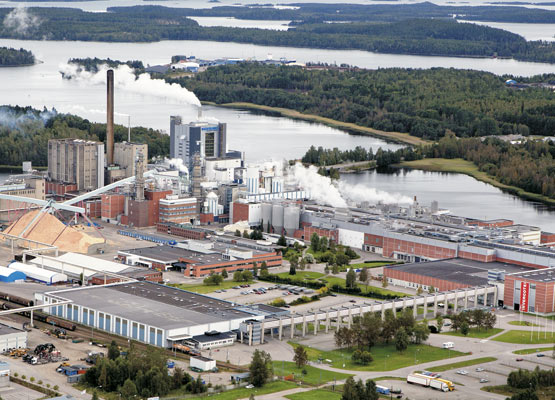Excitement in design education
/INS. “We can do a lot of exciting things in an academic environment. But we can’t recreate the sense of excitement that arises when a company offers us realistic tasks,” explain Sallyanne Theodosiou, Senior Lecturer Graphic Design and her colleague Sophie Beard, both of the University for the Creative Arts, Epsom, UK.
Over the past year they have implemented a project together with Iggesund Paperboard in which the aim was to confront the students with Iggesund’s Invercote paperboard. The students could choose between tasks to do with topics such as packaging construction, infographics and sustainability issues. In addition to the University of the Creative Arts, the other participants were Norwich University of the Arts and the University of Salford.
The project is a joint venture between Iggesund Paperboard, the British trade journal publisher Earth Island Publishing and The Heaven Company. Veronica Heaven, managing director at The Heaven Company developed Brief Cases, a model for cooperation between academia and industry.
Paradoxically enough, Iggesund’s motive for initiating the project was the trend towards digitalisation. At the same time as the entire graphical production process has been simplified and streamlined, the designer has also ended up being farther away from the material, and knowledge of the materials has been eroded.
“For far too many designers, the computer screen is their interface to the rest of the world,” explains Staffan Sjöberg, who is responsible for the project at Iggesund. “Knowledge about the importance of choosing materials is not as strong as it was 25 years ago. Our goal is to get more designers to realise that the right choice of material can be the difference between success and failure.”
“Meeting young ambitious design students is one of many activities we are doing in order to increase the presence of Invercote in the UK. We already have a strong market position for Incada but there is definitely room for more Invercote,” adds Brendan O’Sullivan, in charge of Iggesund sales in UK and Ireland.
Iggesund Paperboard manufactures Invercote and Incada, in Sweden and in the UK They are two different types of paperboard material but both are at the top of their market segment in terms of quality. They are both made of virgin fibre and are constructed in multiple layers, unlike traditional paper. The multi-ply construction creates an extra stiffness and makes it possible to fold both paperboards without them cracking.
“It’s not unusual for a company to make a huge effort to find a creative designer and then to search intensively for a photographer with originality. He or she then wants to work with models who have a good reputation. When the result of all this work is ready, it is then handed over to be printed or converted without giving a thought to what material it should be printed on and why,” Sjöberg emphasises. “There are many examples of things going really wrong, and that’s one of the reasons why we are committed to encouraging designers to think more about their choice of material.”
For a company like Iggesund, though, such work involves a lot more than just influencing tomorrow’s designers. The focus has lain on Iggesund’s sustainability efforts, the fact that the company has been singled out as a model by the Carbon Disclosure Project, and that the company is included on the Global Compact list of the world’s 100 most sustainable companies.
“It’s a welcome reality check to see how many young people in an educational setting accept our reasoning about sustainability issues,” Sjöberg adds. “If we can’t convince them, we should think again.”
For Sallyanne Theodosiou at the University for the Creative Arts the collaboration has been fruitful.
“Of course that’s because the students had the opportunity to work with Invercote, but also because Iggesund Paperboard provided both realistic tasks and relevant feedback. That type of collaboration is incredibly important for our students,” she says.
Caption 1:Dan Thorne, Craig McFarlane and Eddie Magee, design students at the University of the Creative Arts in Epsom showing their idea of how to convey Iggesund’s environmental performance.© Iggesund
Caption 2: Sallyanne Theodosiou, Senior Lecturer Graphic Design at the University of the Creative Arts in Epsom, and Mike Morris, editor of Packaging Solutions are examining a laser cut card made on Invercote from Iggesund Paperboard.© Iggesund
Iggesund
Iggesund Paperboard is part of the Swedish forest industry group Holmen, one of the world’s 100 most sustainable companies listed on the United Nations Global Compact Index. Iggesund’s turnover is just over €500 million and its flagship product Invercote is sold in more than 100 countries. The company has two brand families, Invercote and Incada, both positioned at the high end of their respective segments. Since 2010 Iggesund has invested more than €380 million to increase its energy efficiency and reduce the fossil emissions from its production.
Iggesund and the Holmen Group report all their fossil carbon emissions to the Carbon Disclosure Project. The environmental data form an integral part of an annual report that complies with the Global Reporting Initiative’s highest level of sustainability reporting. Iggesund was founded as an iron mill in 1685, but has been making paperboard for more than 50 years. The two mills, in northern Sweden and northern England employ 1500 people.
Further information:
Staffan Sjöberg
Public Relations Manager
staffan.sjoberg@iggesund.com
Iggesund Paperboard
SE-825 80 Sweden
Tel: +4665028256
Mobile: +46703064800
www.iggesund.com












Let us know if you are going to use this press release. Thank you!